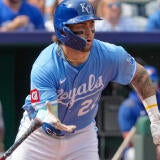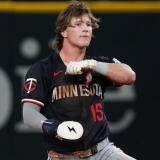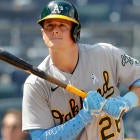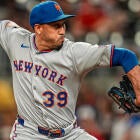2022 Fantasy Baseball Draft Prep: Let's hope history repeats itself with the Matt Chapman trade
The Blue Jays can hope for a huge Josh Donaldson-like score

Matt Chapman has long shared a lot of similarities with former MVP Josh Donaldson. Both started their careers with the Athletics as strong defenders with inconsistent bats who seemed like they might fare better outside of the A's massive home park. We saw Donaldson explode upon his trade to the Blue Jays in 2015, and Chapman is looking to follow in his footsteps after being dealt to Toronto on Wednesday.
Chapman has been arguably the best defensive player in the league since his debut, and he's shown flashes of big potential with the bat before falling on hard times in recent seasons. The Blue Jays shipped out a package of prospects to bolster their third base spot with the hopes that he can also regain his stroke and make one of the best lineups in the game even stronger.
Let's take a look at what this trade means for both sides, starting with Chapman before we take a look at the prospects the Blue Jays received.
The Blue Jays acquire Matt Chapman
The Donaldson comp isn't perfect for Chapman, obviously. He derives more of his value from his defense while striking out quite a bit more than Donaldson did, and Donaldson never had a full season in Oakland as bad Chapman's in 2021 with the bat. However, it is nonetheless pretty interesting to compare them through their age-28 seasons, when both were shipped off to Toronto:
Donaldson: .268/.347/.458 (.805 OPS), 125 OPS+; Per-150 game pace: 23 HR, 80 R, 84 RBI, 5.6 WAR
Chapman: .243/.330/.478 (.808 OPS), 120 OPS+; Per-150 game pace: 29 HR, 89 R, 77 RBI, 6.1 WAR
Given what we know Donaldson would become, it's interesting that Chapman's been better through the same point in their careers. Both were also traded coming off relative down seasons, though Chapman's was worse.
Of course, none of that means Chapman is going to hit .285/.387/.559 in his first three seasons with the Athletics – in fact, I'd certainly bet against that! For one thing, Donaldson didn't have the injury concerns or glaring flares that have cropped up in Chapman's profile over the past two seasons.
Chapman suffered a hip injury in 2020 that required surgery to repair a torn labrum and a cleanup of the femoral head in his right left, and I think it's fair to say it bothered him in 2021. His quality of contact metrics all fell off especially hard; his average exit velocity of 89.7 mph was well below the 92.7 mph mark he managed in each of his three prior seasons. Chapman also had real struggles making contact, though that was also a trend that started in 2020; he's had a strikeout rate over 32.5% in each of the past two seasons, while his whiff rate jumped to 32.7% after sitting between 23.6% and 23.7% in 2018 and 2019, respectively.
However, it wasn't just the bat that took a step back for Chapman, which is why I'm pretty confident the hip is the culprit. Chapman was still a high-level defender in 2020 and 2021, but he fell off from the heights of his 2019 campaign, and it seems his range was hit especially hard. In 2018 and 2019, he was worth 10.0 and 6.1 runs in UZR with his range; in 2021, it was just 1.0 run.
The hip injury and subsequent recovery seem like pretty good explanations for why he struggled, then. If Chapman is in better shape a year further removed from the injury, his chances of bouncing back seem pretty good; if the injury permanently lowered his baseline level of athleticism, then it's possible he just never gets back to that level.
I think it's worth betting on a bounce back, though, and I feel even more strongly about that now that he's in Toronto. This is a massive upgrade in terms of team context, and it's also a significantly better home park to hit in. According to StatCast data, Rogers Center has a 105 park factor for right-handed home runs, compared to an 81 for Oakland; the advantage Toronto offers for batting average for right-handed batters isn't quite as big, but it should be a slight benefit.
If Chapman is right, I think he could be a .270-plus hitter with 35-40 homers in a best-case scenario, and if he did that in Toronto's lineup, the counting stats would be huge. Even if he doesn't reach those highs, a .250 average, 30-plus homers and strong counting stats are a reasonable expectation if healthy.
That would put him in the Nolan Arenado range, though obviously I think he carries plenty of downside risk if he can't fix his strikeout issues. There is significant batting average downside here, which is why he's falling in drafts. I already had him as my No. 14 3B before the trade, just behind Josh Donaldson, and that's where he remains. However, I did move Chapman up from the 175 range to the 150 range, closer to Donaldson, and that feels like a good spot for him.
Chapman is a high-variance player, but both his floor and his ceiling got higher with this move. Potentially much higher.
The Athletics get SP Gunnar Hoglund, IF Kevin Smith, and P Zach Logue and Kirby Snead
This isn't quite what the A's got from the Braves for Matt Olson, but Olson is coming off a career year while Chapman is coming off the worst season of his career, so that makes sense. Still, there's some interesting talent here. Let's go player by player to see what you need to know about for 2022 and beyond:
- Gunnar Hoglund – Hoglund is the prize here. He was twice a first-round pick, first with the Pirates (36th overall) in 2018 and then with the Blue Jays (19th) in 2021, and he's a 6-foot-4 right-handed pitcher who occasionally hit and played first base as an amateur. He's viewed as a full-time pitcher moving forward, and potentially a very good one, he might have been a top-10 pick last season if he didn't have Tommy John surgery during his junior season. Before the injury, he was throwing in the mid-90s with his fastball, a hard slider, and a decent changeup, with the occasional curveball, and obviously his future value will depend on how much of that pre-injury arsenal he comes back with. It's not unheard of for young pitchers to come back from Tommy John throwing harder, but as long as Hoglund looks more or less the same, he could be a pretty quick mover through the A's system. Of course, he's probably not pitching until the second half of this season, so we're probably still at least a couple of years away from Hoglund being Fantasy relevant in re-draft leagues. In Dynasty, he's an interesting guy to try to buy low on before he comes back from the injury.
- Kevin Smith – Not the film director and noted jorts aficionado, Smith is a 25-year-old who got his first taste of the majors in 2021. That didn't go well for him – he hit .094 in 36 plate appearances – but that was about the only thing that didn't go right for him in 2021, as he hit .285/.370/.561 in Triple-A. He's shown decent plate discipline outside of a disastrous 2019 where he experimented with a swing change, and he had 21 homers and 18 steals in 94 games in the minors last season. I've piqued your interest, haven't I? Smith is by no means a can't-miss prospect, and he doesn't need to be drafted in most Rotisserie leagues. However, he suddenly has a much more clear path to playing time with the A's, and he could be on the opening day roster. That's enough to make him an immediate AL-only target, and someone you should keep your eyes on with a late-round pick in 15-team Roto leagues.
- Zach Logue – Logue just snuck his way into the MLB.com top-30 prospects for the Blue Jays, but he's an older prospect – 26 in April – who looks like your prototypical command-oriented lefty, the kind of prospect you hope can help fill out a major-league rotation someday. That's a useful player to have in your organization if you are the A's, but nobody's ever particularly excited to have Marco Gonzales in their Fantasy rotation, and that's the type of pitcher Logue looks like. He has a career 3.43 ERA with 8.4 K/9 in the minors, and right now profiles as just an AL-only late-round flier since he seems likely to have a spot in the A's rotation, perhaps as soon as opening day.
- Kirby Snead – Snead got a cup of coffee with the Blue Jays last season, throwing 7.2 innings with seven strikeouts and two runs allowed. He's a reliever only who had a 1.58 ERA and four saves in Triple-A last season while striking out 57 in 40 innings, and he could be a candidate for closing opportunities at some point with Oakland if they're comfortable trusting a lefty in that role. Snead could be Fantasy relevant this season, but unless he gets some buzz as a late-inning guy, you can probably safely avoid him even in AL-only formats.

















